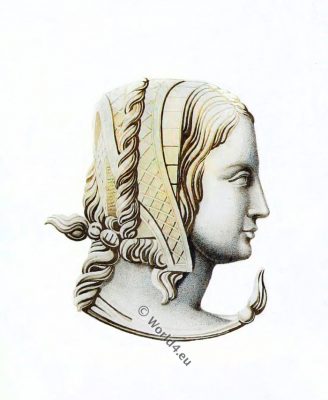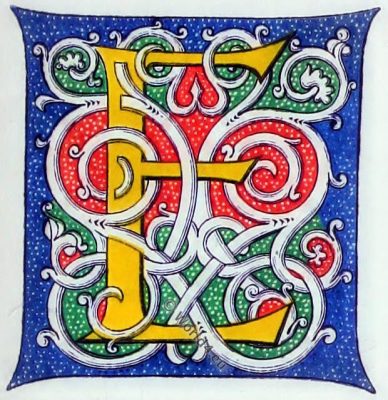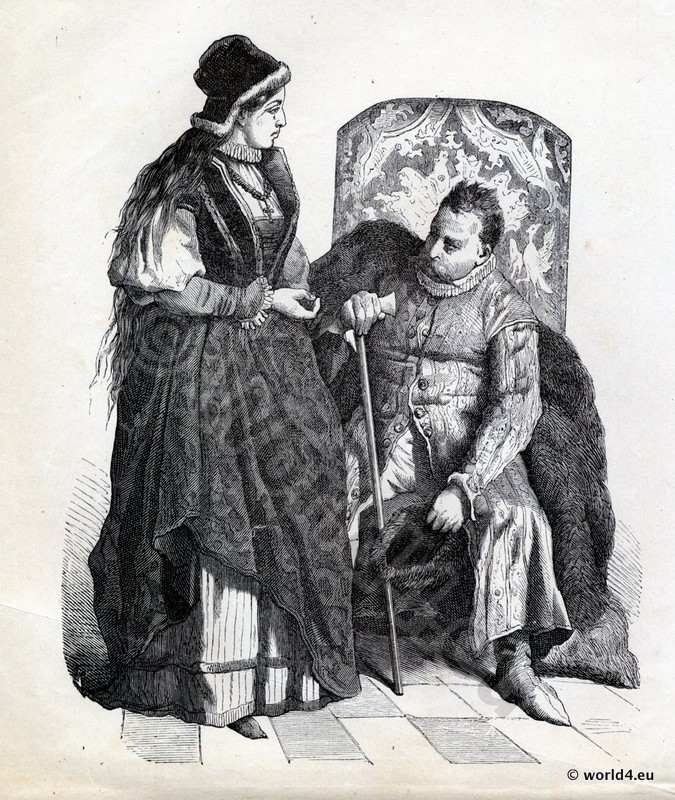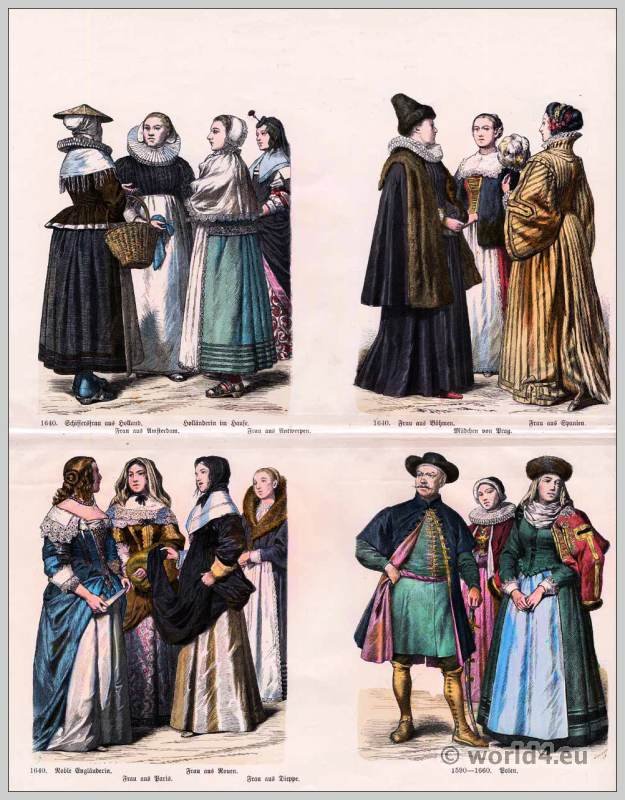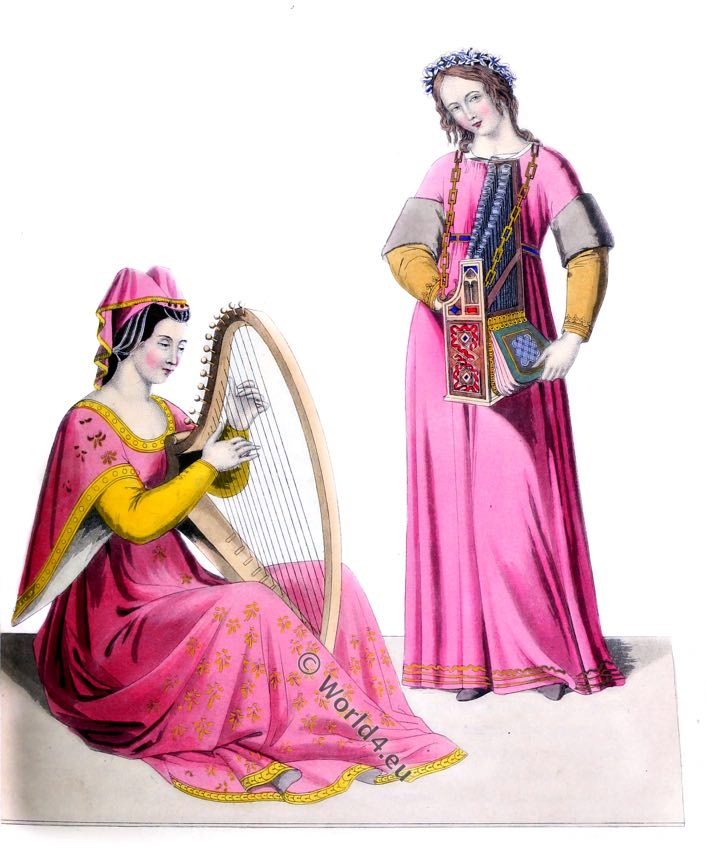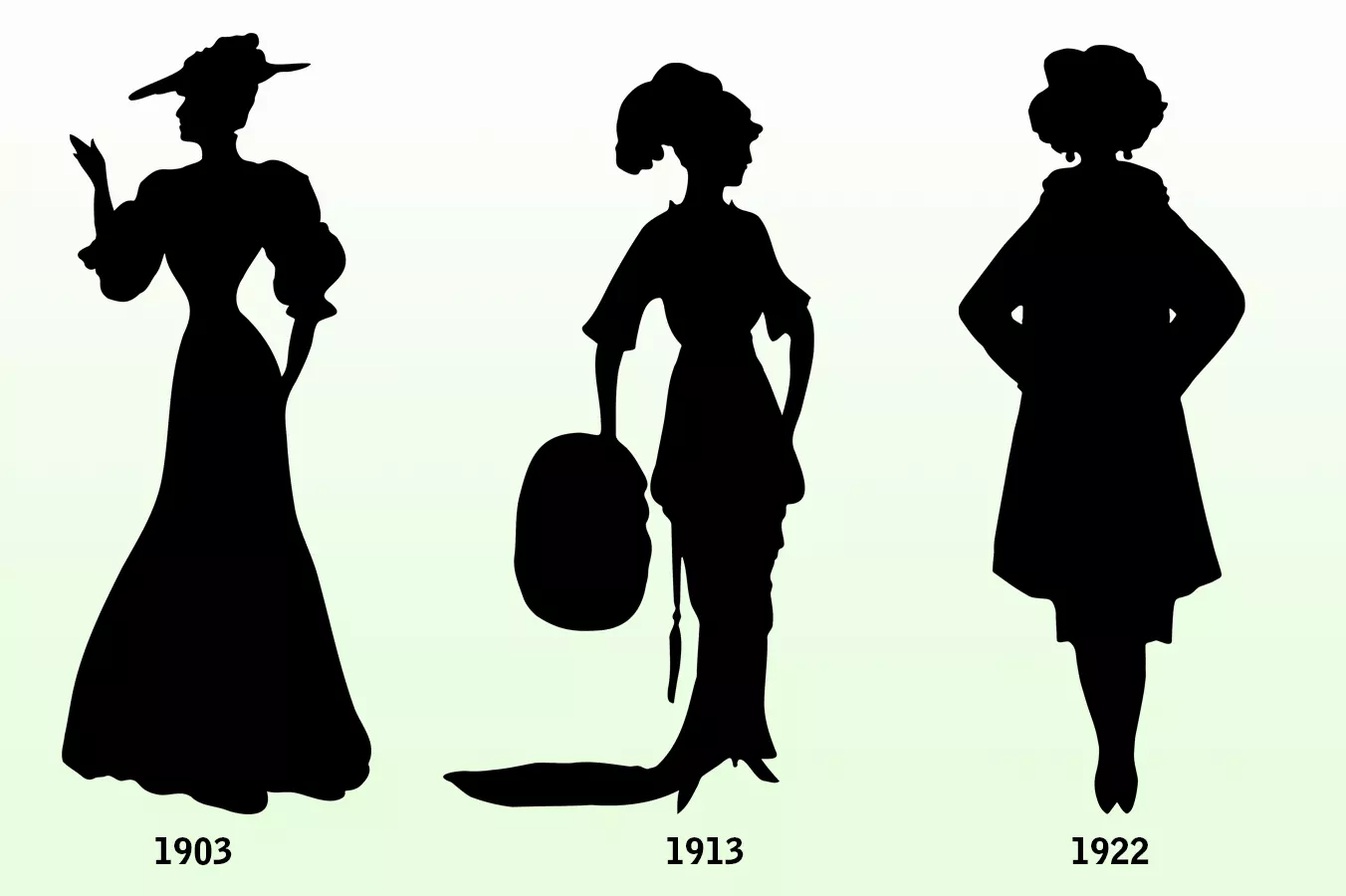Head-dresses of the ladies of the fifteenth century
ELEGANCE and gracefulness, which had seldom exhibited themselves in the horned and peaked head-dresses of the ladies of the fifteenth century, began again to show themselves in the various headdresses of the beginning of the sixteenth. This was more especially visible in France, which country, then as now, took the lead in the fashions of dress.
But even in England, in the reign of Henry VIII., many of the forms of female costume bore a close resemblance to those which are continually re-producing themselves in the modes of the present day.
Head-dresses at the beginning of the 16th century.
This book, written at the beginning of the sixteenth century, consists chiefly of proverbs, adages, and similar matter, among which are a series of imaginary portraits of celebrated ladies of ancient history or fable, drawn in sepia, and represented in the costume of that age, under the names “Hypponne, Penelope, Lucrece, Claudie, Semiramis, Ceres, Porcie Romaine.”
With each of these heads is a brief character in French prose of the personage represented. The three here given are distinguished by the names of Lucretia, Penelope, Hipponne. The inscription over the head of the latter personage will serve as a specimen of the rest.
Hypponne, la chaste Grecque, fut si vertueuse et constante, que pour garder sa virginité, ainsi qu’elle fut prinse sur mer et illec enclose dedens ungne navire de ses ennemis, voyant qu’ils vouloient faire effort de la violler, elle soubdainement, pour esviter leur dampnable entreprise, se lança et gesta en la mer, et ainsi mourut. Le semblable fit Britonne de Crete, pour se que Mina roy de la province la vouloit violer et prandre par force.
Beneath the figure is the following distich,—
“Hippo se gesta en la mer,
Pour sa virginité garder.”
The caul, under which the hair is gathered in the two first of these figures, is frequently mentioned as an article of attire in England in the reign of Henry VII.; whose queen, Elizabeth of York, according to the authority in Leland, at her coronation, wore her hair hanging down her back with “a calle of pipes over it.”
The band on the fourth head, running round the temples, and ornamented with jewellery, appears to be the ‘templette,’ spoke of by Olivier de la Marche, in his Parement ou Triomphe des Dames.
The third figure on this plate, is said to be a portrait of Anne of Bretagne, the wife of Francis I. of France, who reigned from 1515 to 1547. Willemin, however, thinks it more probable that it was intended for Francis’s first wife, the beautiful Claude de France.
The initial letter is taken from the early edition of Pliny, which has furnished us with one or two others.
The wood-cut below, taken from an illuminated MS. written in the fifteenth century and now preserved in the valuable and extensive library of the Arsenal, at Paris, represents some kind of religious or household vessel. It has been supposed to be a cibory or reliquary, in which were placed the sacred relics, and which sometimes was used for the same purpose as the pix. The ornamental mounting is gilt, while the cup itself appears to be of glass.
Source: Dresses and Decorations of the Middle Ages by Henry Shaw F.S.A. London William Pickering 1843.
Related to:
Byzantine, Medieval, Gothic, Burgundian, Renaisance fashion history
- The Barbarian Invasions. The Migration Period. (Historical Atlas)
- The Gallic and Gallo-Roman costume period. 3rd to 4th century
- Byzantine costume history. 5th to 6th century.
- Frankish Merovingian costume history. 4th and 5th century
- Carolingian Period 752-987. Reign of Charlemagne.
- The Carolingian Fashion Period 987 to 1270.
- Europe in the time of Charles the Great 768 – 814. (Maps, Places).
- The Corset and the Crinolin. Fashion history from Ancient until 19th century.
- 11th to 13th century. French fashion history.
- 11th to 13th century. German fashion history.
- 11th to 15th century. Caps and Hoods fashion.
- 13th century. French male fashion history.
- 14th century. German fashion history.
- 15th century. German male fashion history.
- 15th century. German female fashion history.
- 14th, 15th century. Italian fashion history.
- Eleanor of Aquitaine, Medieval Queen in the 12th century. Fashion history.
- Eleanor of Castile first wife of King Edward I. England 13th century
- Reigns of John and of Charles V. 1350 to 1380. (Medieval, Byzantine, Gothic)
- Reigns of Charles VI. and Charles VII. 1380 to 1461. (Medieval, Gothic, Burgundy)
- Headdresses of the 14th Century.
- Headdresses of the 15th century. The Hennin.
- Headdresses 15th century. The Reticulated Headdress.
- The Influence of the Crusaders to the French clothing. 13th to 14th century.
- The Knights Hospitallers. The First Crusade. 11th century.
- The Knights of the Teutonic Order of Knighthood. History of German Crusaders 12th century.
- The Crusades. The Knights Templar. Medieval military religious order. 12th century.
- Syria during the period of the crusades. Maps, Names, Places. Historical Atlas.
- Life-size warrior figures in full armor and equipment. Greek, Roman, Gallic, Merovingian, Carolingian.
- Armor in England from the 10th to the 18th century
- The Rise of Monachism. Monastic costumes history.
- The Romance of the Rose. The Art of courtly love.
- The Lady of Tournament delivering the Price.
- On the history of costumes. From Ancient until the 19th century.
Discover more from World4 Costume Culture History
Subscribe to get the latest posts sent to your email.

